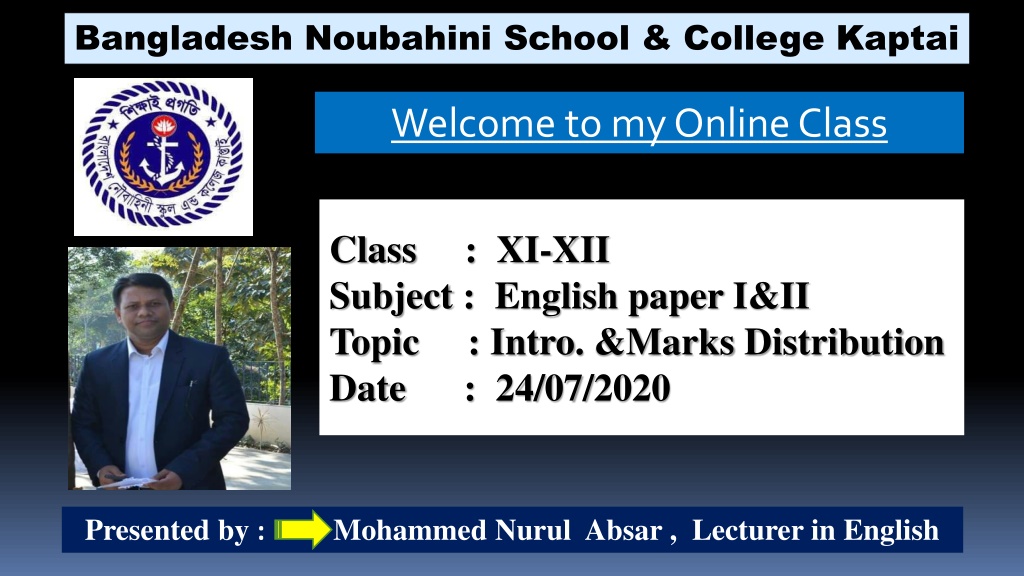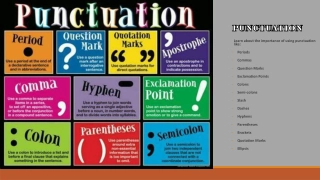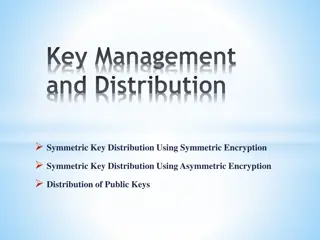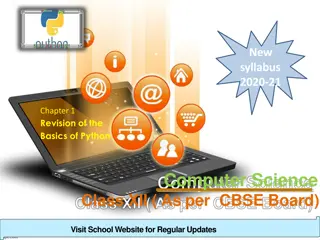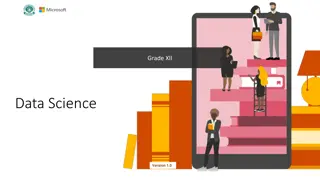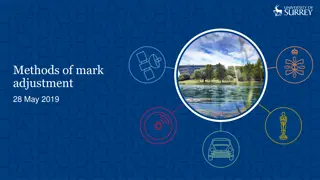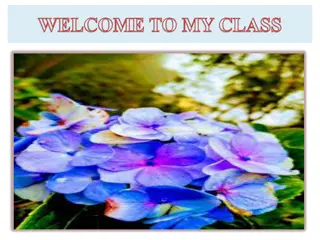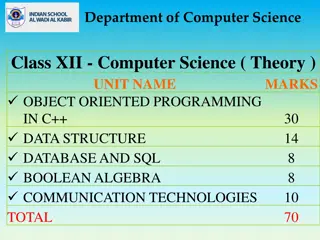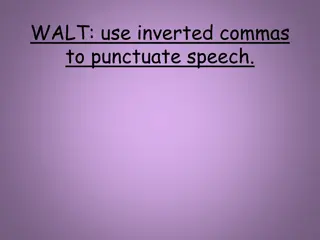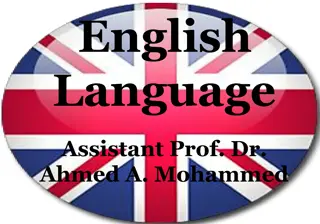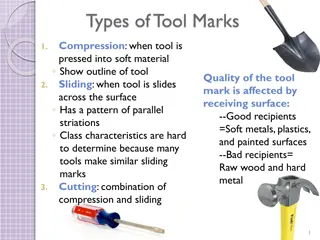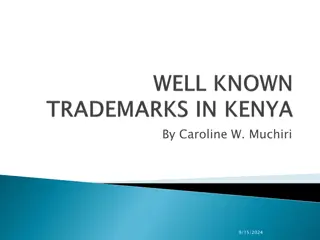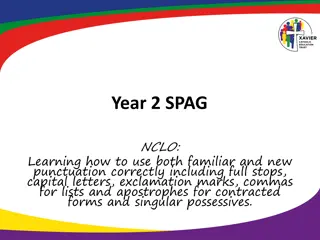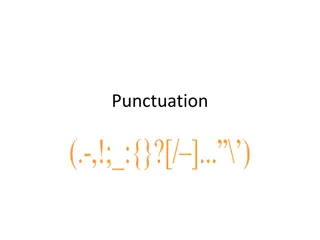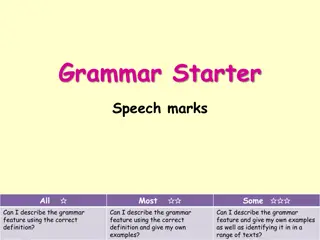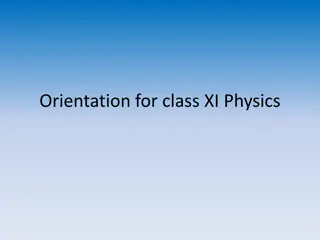Online Class Introduction & Marks Distribution for English XI-XII
Welcome to the online class session for English paper I & II at Bangladesh Noubahini School & College, Kaptai. The session conducted by Mohammed Nurul Absar, Lecturer in English, covers the introduction and marks distribution for the upcoming lessons. Learning outcomes include understanding marks distribution, question formats, and effective answering techniques. The curriculum focuses on language skills acquisition, communication effectiveness, grammar competence, and literary appreciation in English. Students will develop creativity, critical thinking, and language proficiency for real-life and academic contexts.
Uploaded on Nov 24, 2024 | 0 Views
Download Presentation

Please find below an Image/Link to download the presentation.
The content on the website is provided AS IS for your information and personal use only. It may not be sold, licensed, or shared on other websites without obtaining consent from the author. Download presentation by click this link. If you encounter any issues during the download, it is possible that the publisher has removed the file from their server.
E N D
Presentation Transcript
Bangladesh Noubahini School & College Kaptai Welcome to my Online Class Class : XI-XII Subject : English paper I&II Topic : Intro. &Marks Distribution Date : 24/07/2020 Presented by : Mohammed Nurul Absar , Lecturer in English
Bangladesh Noubahini School & College Kaptai Yes, Today s topic is Introduction & Marks Distribution
Learning outcomes After studied this lesson, we will be able to Know the marks distribution Have a clear idea about question format Know the way of answering questions
Total Unit: 15 Page : 205 English - 1
Objectives of National Curriculum 1.To acquire competence in four language skills, i.e. listening, speaking, reading and writing. 2.To use the competence for effective communication in real life situations locally and globally at intermediate level. 3.To acquire necessary grammar competence in English language for better accuracy. 4.To use English literary pieces for enjoyment and language learning.
5.To develop creativity and critical thinking through English language. 6. To become independent learners of English by using reference skills. 7. To use language skills for higher studies and technical education. 8.To be skilled in inter-cultural communications for better access to the globalised world. 9.To use English language skills for lifelong learning where necessary.
Learning Outcomes : Students will be able to 1. Follow and give instructions, directions, requests, announcements and respond accordingly in social situations (listening, speaking) 2.Follow lectures and take notes (listening, writing) 3. Describe people, places, and different cultures (speaking, writing ,listening,) 4. Narrate incidents and events in a logical sequence (speaking,writing) 5.Ask for and give suggestions/opinions(listening, speaking, writing) 6.Participate in conversations, discussions, and debates(speaking, listening)
7.Read,tell and analyse stories (reading, speaking, listening) 8.Recognize and use English sounds, stress and intonation appropriately while listening and speaking(listening, speaking) 9.Listen for specific information on radio, television, and other announcements (listening) 10.Read, understand, enjoy, interpret and critically appreciate stories,short plays,poems,and other literary pieces(reading, writing, speaking, listening) 11.Read, understand and critically appreciate nonfiction works.(reading, writing, speaking) 12.Read, understand and follow authentic texts and signs i.e. instructions, directions, sign posts and notices (reading, listening) 13.Surf the net (reading, writing)
14.Describe a process(speaking, writing) 15.Read and write formal and informal letters, CVs/resumes, emails(reading, writing) 16.Use references in writing and making bibliography(reading, writing) 17.Read, describe, understand and interpret maps, charts, graphs etc.(reading, writing,speaking,listening) 18.Carry out study/ survey/project, write reports, and present the findings orally and in writing (speaking, writing) 19.Write formal, informal, academic, professional and other genres of texts e.g. descriptive, narrative, argumentative(writing) 20.Speak, read, and write English accurately in all aspects of communication. (speaking,reading, writing
Marks Distribution for Classes 1112 Subject: English Test items for Paper I & II) and distribution of marks For the HSC Examination English Paper- I
Reading test : 60 Marks 1 . (A) MCQ (guessing meaning from context) 05 ( B) Comprehension questions 10 2. Information transfer/ flow chart 3. Summarizing 10 10 4. Cloze test with clues 05 5. Cloze test without clues 10 6. Rearranging 10 Writing Test : 40 Marks 7. Writing paragraph answering questions 10 8. Completing a story 9. Writing informal letters/e-mails 05 10. Analyzing maps/graphs/charts 11. Appreciating short stories / poems -------------- 100 07 10 08 (Identify theme, subject-matter And interpretation)
SEEN PASSAGE -1 1. Read the passage and answer the questions A and B. Tertiary education in Bangladesh comprises two categories of institutions: degree awarding universities and colleges affiliated with the National University (NU Accessibility to higher education implies that students get the opportunity to get university education and sufficient support from educational institutions. Increasing enrolment at the secondary and higher secondary level puts pressure on higher educational institutions. But due to limited capacity, only a small number of students may be enrolled in universities. Thus, each year a large number of students are denied access to higher education. Also, due to poverty and increase in educational expenses, students of the lower middle class do not get easy access to higher education. Moreover, those who get places in the universities have limited access to avail all kinds of diversified educational facilities relating to their study fields. 16
A. Choose the correct answer from the alternatives. 5 5 (a) Tertiary education refers to i. secondary education ii. university education iii. primary education iv. higher secondary education (b)The word affiliated stands for i. discarded ii. authorized iii. associated iv. Supervised (c)Public universities are funded by i. World Bank ii. government iii. private sector iv. other donors 17
(d)The private sector came ahead to set up universities in the i. early nineteen nineties ii. late nineteen seventies iii. late nineteen eighties iv. early nineteen eighties (e) ...those who get places in the universities have limited access to avail all kinds of diversified educational facilities relating to their study fields. -- What does k imply? i. lack of teachers ii. technological support is not sufficient iii. library facilitates are not enough iv. all the above answers Ans. To The Question No.--- 01(A) a. i secondary education b. iv. supervised c. iii. private sector d. iv. early nineteen eighties e. ii. technological support is not sufficient
B. Answer the following questions. 2x5=10 (a) How do you differentiate National University from other public universities? (b) What changes do you notice in tertiary education after Liberation War? (c) Why did private universities emerge though there were public universities? (d) How do you explain spectacular growth of private universities in Bangladesh? (e) University should be accessible to the very good students only. Do you agree or disagree with this statement? Give reasons.
Ans. To The Question No.--- 01(B) a. b. c. d. ------------------------------------------------------------------------------------------------------------------------------------ - e. ------------------------------------------------------------------------------------------------------------------------------------- - 20
Seen passage- 2 2.Read the passage and complete the table below with the given information. Unsafe levels of pesticides are present in around half of the vegetables and more than a quarter of fruits sold in the capitals markets, a recent survey has found. A 15-member team of the National Food Safety laboratory, with support from the Food and Agriculture Organization (FAQ), came up with the findings after collecting and testing food samples from the capital s Guishan, Karwanbazar and Mohakhali markets. The survey report, a copy of which was acquired by the Dhaka Tribune, read that nearly 40% of 82 samples of milk, milk products, fish, fruits and vegetables contained banned pesticides such as DDT, Aidrin, Chlordane and Heptachlor. The amounts of pesticide in these samples were found to be 3 to 20 times greater than the limits set by the European Union. Around 50% vegetables and 35% fruits were found to be contaminated with unsafe level of pesticides. 01 x 10 = 10 21
What/who Source What/Where When around half of the vegetables and (ii) - - samples (i)........................... the capital s markets a recent survey (iii)........................... (iv)....................... the National Safety Laboratory research time Food They contamination of food (v)........................ (vi)........such as DDT, Aldrin, and Heptachlor The amount pasticides nearly 40% of 82 samples of milk, (vii).......................... (viii)............. set by the European Union Chlordane the capital s markets after testing of these samples survey around and 35% fruits (x)............... They (ix)................ research time
2. (or) Read the above passage again and complete the following flow chart showing the characteristic/ feature of folk music . (The first one is done for you) Having great variety
Ans. To the Q.No: 2 A flow chart showing the characteristic/ feature of folk music is written below : 1. Having different variety 2. Being composed on the culture ,festivals ,view of life etc . 3. Using simple and natural rhythms 4. Depending upon nature and rural environment 5. Containing a strong emotive expression of human love 6. Having not been influenced by classical or modern music.
3. Write a summary of the following poem. 10 I will arise and go now, and go to Innisfree, And a small cabin build there, of clay and wattles made: Nine bean rows will I have there, a hive for the honey bee And live alone in the bee loud glade. And I shall have some peace there, for peace comes dropping slow Dropping from the veils of the morning to where the cricket sings; There midnight s all a glimmer, and noon a purple glow, And evening full of the linnet s wings I will arise mid go now, for always night and day I hear lake water lapping with low sounds by the shore; While I stand on the roadway, or on the pavements grey, I hear it in the deep heart s core. Ans. To The Question No.--- 03 -------------------------------------------------------------------------------------------------------------------------------------------------- -------------------------------------------------------------------------------------------------------------------------------------------------- --------------------------------------------------------------------------------- 25
4. Read the following text and fill in the blanks with suitable word from the box. There are more words than needed. Make any grammatical change if necessary. 5 be one for should what information it want when as people family Genealogy, the history of a family from the past to the present, is one of the most popular subjects on the Internet. Although genealogy has always been conducted professionally (i) _______ serious legal and financial reasons, as a hobby (ii) _______ began to take off in the 1990s when (iii) _______ started to use the Internet to share information, (iv) _______ embarking on genealogy as a hobby, though, one (v) _______ advised to decide on what it is one (vi) _______ to find out about ones family and what (vii) _______ will do with the information. Firstly, go from (viii) _______ one has already known and worked backwards. One (ix) _______ undertake to find out the basic facts about (x) _______ many relatives as possible: their date and place of birth, marriage, death and burial. 26
Ans. To The Question No.--- 04 i . secondary ii supervised iii. Early iv. Technological v. Term vi. Farmer vii. Mother viii. Institute ix. cultivate x. immortal
5. Fill in the blanks with appropriate word in each gap. 1x10=10 Bangladesh has made considerable progress in achieving the Millennium Development Goals (MDGs), particularly in poverty alleviation. The goal was to reduce poverty to 29 (i) _______ by the year 2015. Two years ahead (ii) _______ time, in 2013, it has been possible (iii) _______ bring this down to 26.2 percent. Among (iv) _______eight goals of MDG, it will be (v) _______ to fully meet the targets set for (vi) _______ infant mortality and improving maternal health. The (vii) _______ which will not be fully met are (viii) _______ extreme poverty and hunger, achieving universal primary (ix) _______, achieving gender equality and empowerment of women. (x) _______ Bangladesh is considering the achievements made in these sectors to be successful.
Ans. To The Question No.--- 05 i . secondary ii supervised iii. Early iv. Technological v. Term vi. Farmer vii. Mother viii. Institute ix. cultivate x. immortal
6. The following sentences are jumbled. Rearrange them in proper sequence. 1 10=10 (i) As a student, Luther King was brilliant. (ii)He denoted all the money for the development of the Negro Nation. (iii)After marriage, Luther King worked as a clergyman in the Baptist Church of Alabama. (iv) He was born on 15th January 1929 in the Atlanta city. (v)He was shot dead in 1966 when he was only 37 years old. (vi)He was awarded Nobel Prize for leading the racial problem of America in a non-violent and peaceful way. (vii)In this time, he married an extraordinarily learned woman called Corotta Scott. (viii)Martin Luther King Jr. was a great leader in the history of freedom and rise of the Negro Nation. (ix)He was imprisoned for his movement against the colour difference. (x)He obtained his doctorate degree from Boston University. Answer to the Q. No: 6 Self Practice a
Part II : Writing (40 Marks) 7. Write a paragraph on 'Digital Bangladesh' on the basis of the answers to the following questions in about 200 words. 10 (a)What is digital Bangladesh? (b) (b) How can it be achieved? (c) (c) What, you think, (d)should be the work plan of government to this effect? (e) (d) How can students contribute to attain it? (f) (e) Do you think the idea too ambitious?
8. The following is the beginning of a story. Complete it in your own words. 7 There once lived a poor farmer. He had a goose. It used to lay a golden egg everyday. He sold the golden eggs in the market. He was very greedy ..................... 9. Suppose, you are Tapu. Now, write an email to your friend telling him about how you have prepared yourself for the ensuing HSC Examination. 5
10.The following bar graph shows the annual growth rate of GDP in Bangladesh from the fiscal year 2006 to 2015. Describe the graph in at least 80 words. You should highlight the information and report the main features given in the graph. 10 GDP growth rate of Bangladesh
Part I Grammar test Marks - 60 1. Gap filling activities without clues (for articles ) 2. Gap filling activities without clues (for propositions) 3. Gap filling with special uses of phrases and words 4. Completing sentences (use of conditionals, phrase, and clause) 5. Use of verbs (right form of verbs and subject verb agreement as per context) 6. Changing sentences (change of voice, sentence types, degrees) 7. Narrative style (direct to indirect and vice versa) 8. Completing sentences 9 . Use of modifiers 10. Use of sentence connectors 11, Use of synonym and antonym 12. Punctuation
Part II Writing test Marks - 40 Composition Part Formal letter/emails 08 Report writing (for newspapers) 08 Paragraphs (based on one of the paragraph types:listing,narration, comparison and contrast, cause and effect) 10 Free writing:descriptive, narrative, persuasive/argumentative,imaginative and creative writing of 200- 250 words based on personal experience, everyday problems, familiar topics , recentevents and incidents etc. 14
